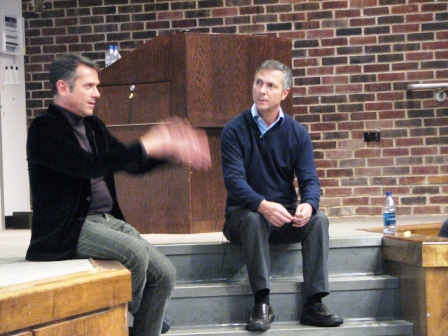Making the case for blending old and new

Feb. 18
By Alan Jaffe
For PlanPhilly
Fernando and Humberto Campana integrate the primitive and the progressive — the Indian culture of their native Brazil and the modernity of present-day Sao Paolo, the organic materials of their homeland and the industrial products that invaded it.
Their ability to synthesize these contrasting sources was a fitting subject for tonight’s presentation in the Integrated Product Design lecture series in Meyerson Hall at Penn’s School of Design. The series, sponsored by Lisa Roberts, author of “Antiques of the Future,” and her husband David Seltzer, is part of the University of Pennsylvania’s new master’s degree program, an interdisciplinary course of study that utilizes faculty from the schools of design arts, engineering and business. Monday night’s lecture was the third in the series intended to bring renowned industrial designers to the campus.
Roberts explained that she was a fan and owner of several pieces created by the Campana brothers, who use mainly inexpensive, found materials – both indigenous species and recycled products – to craft complex, beautiful designs.
Among her favorites, she said, are the Campanas’ “favela chair,” made of discarded pieces of wood, and the “sushi chair,” which consists of rolled fabrics that are sliced like pieces of sushi.
Humberto, who trained as a lawyer, and Fernando, who studied architecture, have become internationally admired furniture designers whose work is “mass produced, but retains an element of the hand-crafted look, which distinguishes their work,” Roberts said.
The two brothers presented their lecture together, beginning with a lesson in the art history of Brazil. While everyone in Brazil now speaks Portuguese, the nation is “a big blend of cultures,” Fernando said.
Flashing drawings of early Brazilian Indians preparing to cook and cannibalize a missionary, the Campanas explained that the native and European cultures sometimes clashed.
But those early Indians also produced hand-crafted funeral urns, stools used for prayer and meditation, and huge domes covered with straw that inspired the brothers’ work centuries later.
“Brazil is a melting pot of races,” Fernando said, “but Brazilians did not explore their own culture until the 1930s.”
Artists such as Oscar Niemeyer and Roberto Burle Marx rebelled against European influences and searched for the unique cultural identity of Brazil in their work. “They inspired the modernity of Brazilian art,” Fernando said, and paved the way for other artists to find their roots.
“I wanted to be a Brazilian designer, not any other nationality,” Humberto said.
The brothers began their work with a basket factory that used materials that were native and inexpensive. But they also used materials that were readily available. Humberto purchased a cheap roll of rope, then strung 450 meters of it around a circular chair frame of his own design. They sold just a few of the chairs in Sao Paolo.
But the chair also appeared in a design anthology, and caught the eye of a famous Milan furniture maker. When the manufacturer asked the brothers to send drawings showing how to reproduce the chair, they realized it was to complex for drawings. They sent a video of Humberto winding the rope around the frame.
The rope chair is now included in the collections of the Museum of Modern Art and the Cooper-Hewitt National Design Museum in New York.
“It was our best-seller,” Fernando said.
The brothers’ designs include a “boa sofa,” a series of 12 tubes laced together like intertwined snakes, and a second version that utilizes plush alligator shapes.
One of their better known works is the “multi-doll chair,” which consists of compacted dolls made by young Brazilian girls. The brothers worked with local communities to help their economy by producing the elements of the chairs.
They have also returned to Portuguese basket-weaving to create a line of furniture made of wicker, which is extracted from the Amazon forest using “eco-friendly” methods, Fernando said. The furniture incorporates contemporary plastics that had replaced wicker for many years. But in the Campanas’ hybrid furniture, the wicker dominates the manmade materials, as if nature was taking back its place in the world.
“In our work,” Humberto said, “we try to investigate what else can be done.”
To view the work of Fernando and Humberto Campana, go to www.campanas.com.br.
To learn more about the Integrated Product Design Lecture series, go to www.design.upenn.edu. Admission to the lectures is free, but tickets are required; they are available an hour before the start of the program in the lobby of Meyerson Hall.
Contact the reporter at alanjaffe@mac.com
WHYY is your source for fact-based, in-depth journalism and information. As a nonprofit organization, we rely on financial support from readers like you. Please give today.






